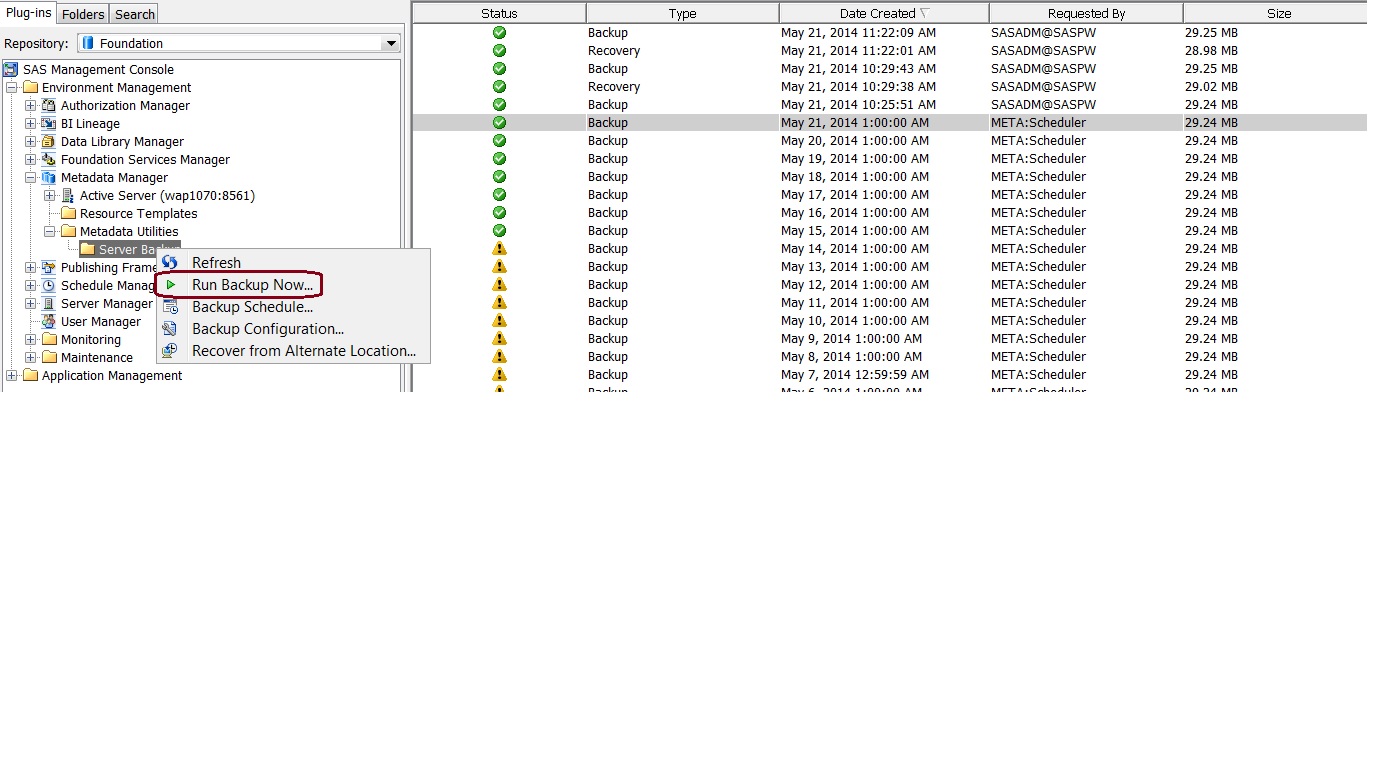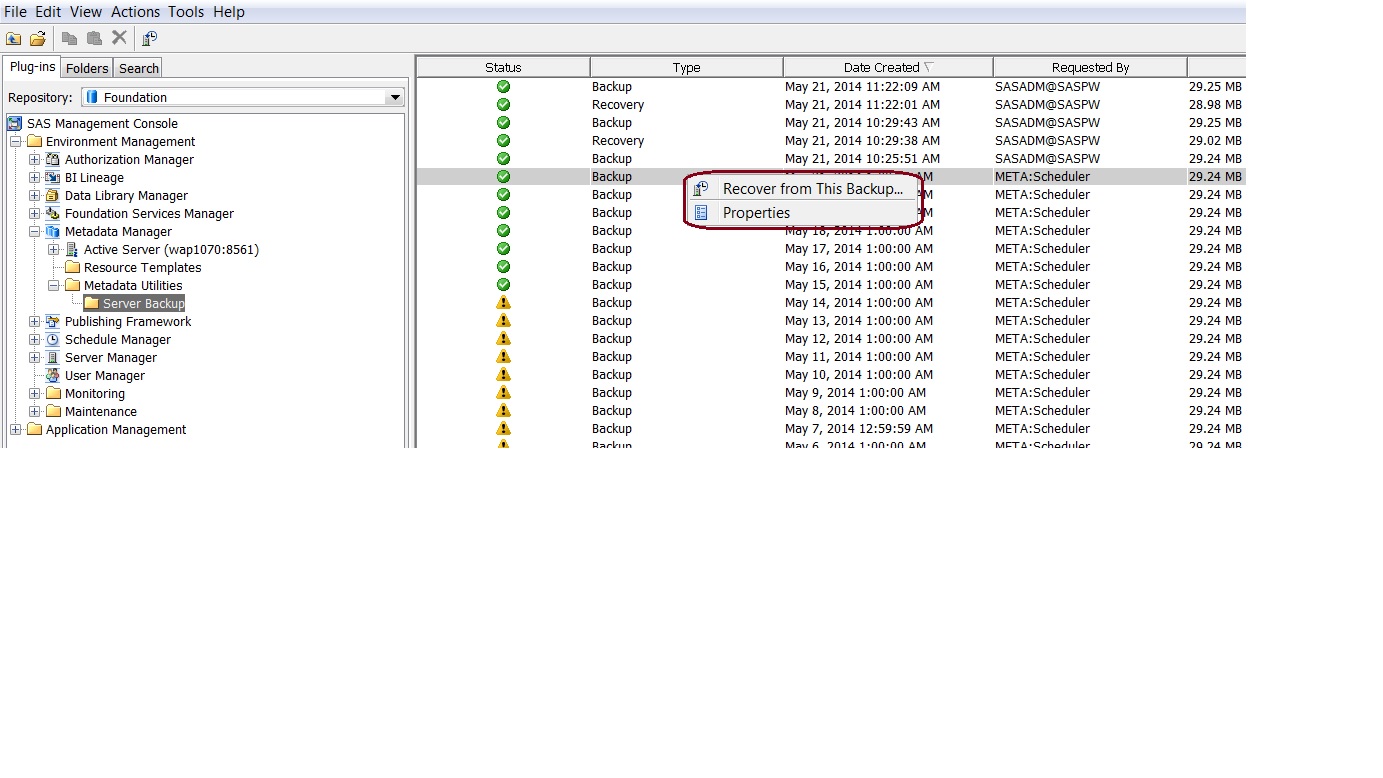- Home
- /
- Administration
- /
- Admin & Deploy
- /
- Re: Metadata backup and recovery
- RSS Feed
- Mark Topic as New
- Mark Topic as Read
- Float this Topic for Current User
- Bookmark
- Subscribe
- Mute
- Printer Friendly Page
- Mark as New
- Bookmark
- Subscribe
- Mute
- RSS Feed
- Permalink
- Report Inappropriate Content
Hello,
I wanted to test the metadata recovery. So, i first ran the backup of the metadata in the test environment. Then, i deleted a user and then recovered from the backup.
But i still cant find the user. Is that not what recovery has to do? Why am i not able to see the user?
- Mark as New
- Bookmark
- Subscribe
- Mute
- RSS Feed
- Permalink
- Report Inappropriate Content
Hi akshatadeshpande,
Have a look at the excellent contribution from Paul Homes -
The important thing to appreciate is that Metadata Backup and Recovery utilities backup (and restore) the entire Metadata Server. So when you restore, you are rolling back all metadata to the point in time at which you took the back. If you want to perform a selective restore, you can use the SAS Configuration Wizard to construct a new/temporary Metadata Server into which you can restore a backup - you can then selectively export the item(s) you want to recover and then import just these items into your target server.
However, it seems to me that you are failing at the first or second hurdle. The first hurdle of backing up the Metadata is quite tricky to fail at, so my guess is that the RESTORE is not actually working. If you can share here the exact steps you are going through, I am sure that somebody from the community will be able to help.
BR,
Unkie
- Mark as New
- Bookmark
- Subscribe
- Mute
- RSS Feed
- Permalink
- Report Inappropriate Content
Hi Ukie,
Thanks for your reply. These are the steps that i carried out:
- Take the backup of metadata, the number of users were 13
- Delete one user, now the number of users is 12
- Restore from the metadata backup which i took before deleting
- After restore i still found that there are only 12 users
Since at the time of taking the backup i had 13 users, ideally restoring the metadata should have 13 users, Right?
- Mark as New
- Bookmark
- Subscribe
- Mute
- RSS Feed
- Permalink
- Report Inappropriate Content
You should certainly expect to return to a state of 13 users.
Can you please share what commands you are issuing for steps #1 and #3.
Please also check this link SAS(R) 9.3 Intelligence Platform: System Administration Guide, Second Edition and confirm that you are following these steps (and not getting a red cross).
Unkie.
- Mark as New
- Bookmark
- Subscribe
- Mute
- RSS Feed
- Permalink
- Report Inappropriate Content
I am doing it using the SAS Management Console. The version of SAS is 9.3
For taking the backup, i am using the Run Backup Now option in the metadata manager plug-in.

- Mark as New
- Bookmark
- Subscribe
- Mute
- RSS Feed
- Permalink
- Report Inappropriate Content
I suspect that when you did the restore you replayed all of the transactions in the journal, including the deletion of the user. Pick a time just prior to the deletion of the user and replay the transactions up to that point, so the deletion is not included. You might find this blog post and the referenced SAS documentation useful: Metadata Time Travel with SAS 9.3 - platformadmin.com
[ Unkie - thanks for the mention! ![]() ]
]
- Mark as New
- Bookmark
- Subscribe
- Mute
- RSS Feed
- Permalink
- Report Inappropriate Content
Paul, You mentioned a common perception mistake of metadata backups. It is the same one as with RDBMS systems.
It is all are nothing approach, not suited for single objects part of that eco-system.
At some moment you have logical correct state off all the related tables/records/data (checkpoint).
You can backup/restore to that moment and perform roll-back roll/forward of modifications from that moment using registered updates.
When you need to be able to view/ (backup/restore) single objects this full approach of metadata is failing.
You clould solve that by saving export packages of needed areas (SLA requirements).
Another confusing topic within this area is DR Disaster Recovery.
In that approach a backup/restore could be an option. But if you go for synchronization and clustering the behavior of that is different again.
You could have a good DR implementation without being able anything being backupped. With that not able going to recover from logical failures.
- Mark as New
- Bookmark
- Subscribe
- Mute
- RSS Feed
- Permalink
- Report Inappropriate Content
Jaap, you are right that it is a complete restoration of all metadata objects as at a particular point in time, and it is more challenging if you only want to recover a small selection of objects from the past state into the current state. If regular metadata export packages from a change management procedure are not available, one potential option is to schedule some outage for the platform and follow the procedure:
- Take a backup of the current state (T0)
- Restore to a past state where the required objects were in a known good state (T1)
- Export a package of selected metadata objects from the T1 restored backup (P1)
- Get back to the current state metadata by restoring from the T0 backup.
- Import the older metadata objects from the P1 package into current state metadata.
Of course, this is all purely metadata. Sometimes there is associated physical content that also needs to be recovered too. In this case recovering a user's metadata identity only involves metadata, but then again for recovering a single user object, it would most likely be much easier to just recreate it manually than follow the procedure above and schedule outage ![]()
- Mark as New
- Bookmark
- Subscribe
- Mute
- RSS Feed
- Permalink
- Report Inappropriate Content
Ok Paul, This reply I could have expected as having heard before. Still it is not an acceptable approach solving backup/restore questions/requirements. For some reason IT people are wanting to invent over and over again what is already there. Using other words for the confusing not recognizing that. It starts with getting clear the business question/requirements.
We had the DR question and fail-over of the total IT configuration with all logical constraints.
The more detailed objects for the business can be either regular developed (D T A P staging) or done on ad-hoc (end user - interactive) base.
When the requirement is that just that content must be rather quick being set to a previous well known state, that is to solve in KISS approach.
Regular:
There will commonly also an segregation between DT - A and P as requirement with different metadata-databases.
The release management will have a deployment process needing packages (export/impiort). Save those packages with documented content and you use for the restore requests.
Ad-hoc
Let an export process of the related involved folders (and all what belongs to that) run at scheduled agreed moments and save those listings.
When a request comes in for a restore use that to fulfill that request. I have seen StigE did this proposal for that approach also (Tricia's blog).
This approach is not really different as well known backup/restore tools for files/data at the OS-level.
Backup - Wikipedia, the free encyclopedia
For the question

- SAS Webinar: Generierung synthetischer Daten | 04-Dec-2025
- Ask the Expert: Wie kann ich Visual Studio Code als SAS Entwicklungsumgebung nutzen? | 11-Dec-2025
- DCSUG Online Winter Webinar | 11-Dec-2025
- Ask the Expert: Marketing Decisions Excellence: Turning Insights Into Business Impact | 16-Dec-2025
- SAS Bowl LVII, SAS Data Maker and Synthetic Data | 17-Dec-2025
- SAS Innovate 2026 | Grapevine, Texas | 27-Apr-2026
SAS technical trainer Erin Winters shows you how to explore assets, create new data discovery agents, schedule data discovery agents, and much more.
Find more tutorials on the SAS Users YouTube channel.



